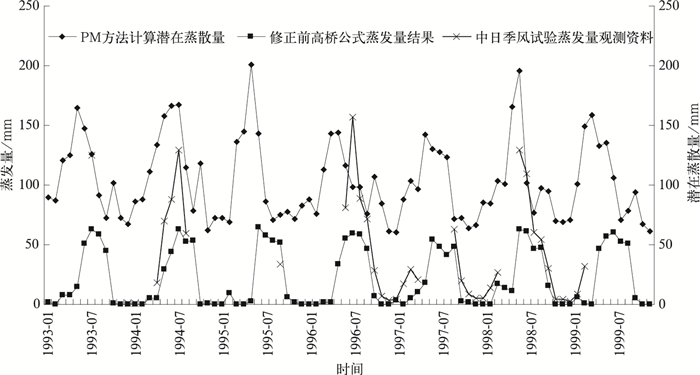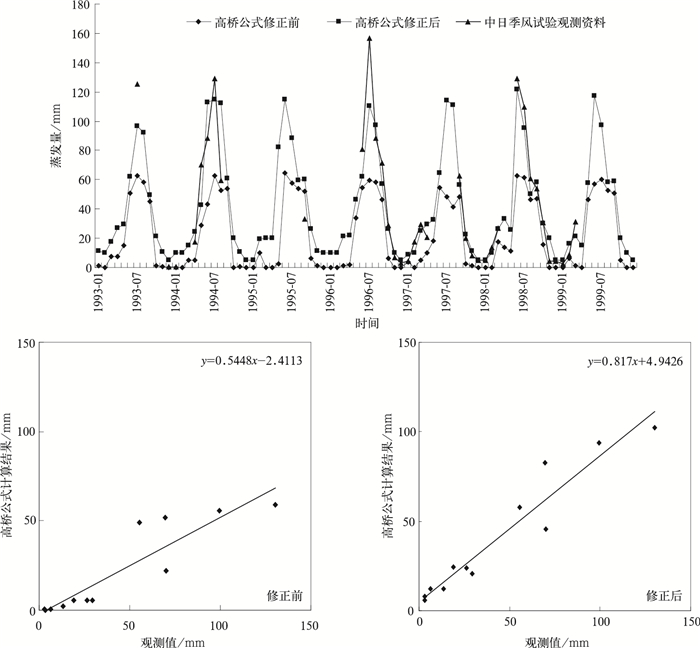The Applicability and Modification of Takahashi Formula for Evaporation Estimation in Lhasa
-
摘要: 选用1993—1999年拉萨站资料,通过比较多种计算方法得到的潜在蒸散量、高桥浩一郎在1979年提出的基于温度和降水量计算蒸发量的公式所得到的蒸发量以及中日季风试验资料的观测值可知:受温度、水分及相对湿度的影响,潜在蒸散量在5月达到最大值,而蒸发量的最大值则出现在7月。由于青藏高原存在冻土及融冰化雪的特殊现象,水分来源并不完全依靠于降水,所以由高桥浩一郎公式的计算值与观测值之间存在较大差距,温度越高,差值越大;鉴于温度与该差值呈正比关系,可将温度划分为小于0℃,0~5℃,5~10℃,10~15℃,大于15℃共5个等级,在不改变高桥浩一郎公式原有系数的基础上,同时考虑不同的系数对降水量进行修正,修正后的结果明显好于修正前,与观测值更接近。Abstract: Researches on the latent heat, the process of water balance and the dry climate of Tibetan Plateau are of great significance. But due to the limits of estimation methods, observation instruments and lack of stations, there is no long, accurate evaporation data on Tibetan Plateau. Therefore, it is important to choose a more efficient, simple formula to estimate evaporation. The data of the Lhasa can represent the average state of the entire Plateau. In order to calculate the evapotranspiration, several methods including Takahashi formula are adopted and the results are compared with data of the Asian Monsoon Experiment. The result shows that the calculated values are close by PM formula, Remanenko formula, Blaney-Criddle formula and Hargreaves formula. The values calculated by PM formula and Remanenko formula begin to increase from January, reaching the maximum in May, and then decreases. But for the values calculated by Blaney-Criddle formula and Hargreaves formula, the maximum appears in July, two months later. The values of Remanenko formula and PM formula are closest, so the Remanenko formula can be used for the area lack of data. The maximum of potential evapotranspiration appears in May, but the evaporation is smaller due to lack of water, though the sun radiation is strong. As the relative humidity increases with precipitation, the potential evapotranspiration decreases, while the actual evaporation reaches maximum in July. The value estimated by the Takahashi formula has large bias comparing with the observation, indicating that Takahashi formula is not suitable for Lhasa. The bias is greater when the temperature is higher, because the frozen soil, ice and snow thaw on Tibetan Plateau have added the uncertainties. Considering the direct proportion between the temperature and the gapbias, the temperature is divided into 5 grades: Lower than 0℃, 0—5℃, 5—10℃, 10—15℃ and higher than 15℃. Without changing the original coefficients of the Takahashi formula, a coefficient is introduced on the precipitation part, which leads to results closer to the observations. The maximum of actual evaporation appears in summer, reaching 100 mm or above, which is slightly less than the measured value of the Asian Monsoon Experiment, and the minimum appears in winter. The value calculated with the modified formula is significantly higher than the original formula, closer to the observed data. But the value in winter is significantly higher than the original value, slightly higher than the observation.
-
Key words:
- Tibetan Plateau;
- evaporation;
- Takahashi formula;
- latent heat
-
表 1 PM方法的潜在蒸散量计算结果与其他方法结果的相关系数对比
Table 1 The comparison of correlation coefficients between values calculated by PM formula and the other formulas
方法 相关系数 Remanenko 0.96 Hargreaves 0.74 Blaney-Criddle 0.64 Linacre 0.63 Kharrufa 0.59 Thornthwaite 0.58 表 2 高桥公式修正前后计算的蒸发量与中日季风试验观测资料对比
Table 2 The comparison of results estimated by Takahashi formula before and after correction to observations
月份 观测值/mm 高桥公式修正前 高桥公式修正后 计算结果/mm 相对误差/% 计算结果/mm 相对误差/% 1 3.1 0.7 76.8 7.9 152.0 2 13.4 2.3 82.7 12.2 8.6 3 29.4 5.3 81.8 20.8 29.1 4 19.1 5.4 71.6 24.5 28.1 5 69.9 22.3 68.2 45.4 35.2 6 99.5 55.5 44.3 93.6 6.0 7 130.3 58.9 54.7 102.6 21.3 8 69.6 51.9 25.3 82.9 19.1 9 55.5 49.1 11.6 57.5 3.7 10 26.4 5.4 79.6 23.8 9.5 11 6.3 0.5 91.7 11.9 88.5 12 3.3 0.1 96.5 5.8 77.7 -
[1] 葛旭阳, 陶立英, 朱永禔, 等.青藏高原热力状况差异与长江中下游地区梅雨关系的相关分析及数值试验.应用气象学报, 2001, 12(2):159-166. http://qikan.camscma.cn/jams/ch/reader/view_abstract.aspx?file_no=20010222&flag=1 [2] 叶笃正, 高由禧.青藏高原气象学.北京:科学出版社, 1979: 2-9. [3] Luo Huibang, Yanai M.The large-scale circulation and heat source over the Tibetan Plateau and surrounding areas during the early summer of 1979 Part Ⅱ:Heat and moisture budgets. Mon Wea Rev, 1984, 112(5):966-989. doi: 10.1175/1520-0493(1984)112<0966:TLSCAH>2.0.CO;2 [4] Chen Longxun, Reiter E R, Feng Zhiqiang.The atmospheric heat source over Tibetan Plateau May—August 1979. Mon Wea Rev, 1985, 113(10):1771-1790. doi: 10.1175/1520-0493(1985)113<1771:TAHSOT>2.0.CO;2 [5] Li Warlin.The Feathers of the Atmospheric Heat Sources over the Qinghai-Xizang in Summer 1979//Liou Kuonan, Zhou Xiuji. Atmospheric Radiation Progress and Prospects. Beijing: Science Press, 1987:99-106. [6] Yanai M, Li Chengfeng, Song Zhangshan.Seasonal heating of the Tibetan plateau and its effects on the evolution of the Asian summer monsoon. J Meteor Soc Japan, 1992, 70(1) :319-350. http://ci.nii.ac.jp/naid/40000634880 [7] 董敏, 朱文妹, 徐祥德.青藏高原地表热能量变化及其对初夏东亚大气环流的影响.应用气象学报, 2001, 12(4):458-468. http://qikan.camscma.cn/jams/ch/reader/view_abstract.aspx?file_no=20010460&flag=1 [8] Su Zhongbo, Zhang Ting, Ma Yaoming, et al. Energy and water cycle over the Tibetan Plateau surface energy balance and turbulent heat fluxes. Advances in Earth Science, 2006, 12(12):1224-1236. http://www.airitilibrary.com/Publication/alDetailedMesh?DocID=10018166-200612-21-12-1224-1236-a [9] 高志球, 卞林根, 程彦杰, 等.利用生物圈模型 (SiB2) 模拟青藏高原那曲草原近地面层能量收支.应用气象学报, 2002, 13(2):129-141. http://qikan.camscma.cn/jams/ch/reader/view_abstract.aspx?file_no=20020217&flag=1 [10] 刘晶淼, 周秀骥, 余锦华, 等.非均匀地表条件下区域蒸发散通量计算方法的研究.应用气象学报, 2002, 13(3):288-298. http://qikan.camscma.cn/jams/ch/reader/view_abstract.aspx?file_no=20020339&flag=1 [11] 高国栋, 陆渝蓉, 李怀瑾.我国陆面蒸散量和蒸散耗散热量的研究.气象学报, 1990, 38(2):165-175. http://cdmd.cnki.com.cn/Article/CDMD-85101-1012409955.htm [12] 高桥浩一郎.从月平均气温、月降水量来推算蒸散发量的公式.天气, 1979, 26(12):29-32. http://kns.cnki.net/KCMS/detail/detail.aspx?filename=qxkj1980s4010&dbname=CJFD&dbcode=CJFQ [13] 文敏, 陈创买.珠海市近50年水资料变化特征及评估.中山大学学报:自然科学版, 2005, 44(2):272-275. http://www.cnki.com.cn/Article/CJFDTOTAL-ZSDZ2005S2062.htm [14] 王韩民, 郭玮, 程漱兰, 等.国家生态安全:概念、评价及对策.管理世界, 2001(2):149-151. http://www.cnki.com.cn/Article/CJFDTOTAL-GLSJ200102018.htm [15] 陈守煜.工程模糊集理论与应用.大连:大连理工大学出版社, 1994:1-101. [16] 何平, 贺明慧, 韩颖, 等.20世纪60—90年代辽东地区气候年代际变化特征分析.气象与环境学报, 2006, 22(3):24-26. http://www.cnki.com.cn/Article/CJFDTOTAL-LNQX200603005.htm [17] 宋正山, 杨辉, 张庆云.华北地区水资料各分量的时空变化特征.高原气象, 1999, 28(4):553-566. http://www.cnki.com.cn/Article/CJFDTOTAL-GYQX199904009.htm [18] 陶云, 赵荻, 何华, 等.云南省大气中水资源分布特征初探.应用气象学报, 2007, 18(4):506-515. doi: 10.11898/1001-7313.20070411 [19] 华维, 范广洲, 周定文, 等.青藏高原植被变化与地表热源及中国降水关系的初步分析.中国科学D辑:地球科学, 2008, 38(6):732-740. http://www.cnki.com.cn/Article/CJFDTOTAL-JDXK200806008.htm [20] 李国平, 赵邦杰, 卢敬华.青藏高原地面总体输送系数的特征.气象学报, 2002, 60(1):60-67. doi: 10.11676/qxxb2002.007 [21] 李国平, 段廷扬, 巩远发.青藏高原西部地区的总体输送系数和地面通量.科学通报, 2000, 45(8):865-869. http://www.cnki.com.cn/Article/CJFDTOTAL-KXTB200008014.htm [22] AllenR G, PereiraL S, Dirk R, et al. Crop Evapotranspiration Guidelines for Computing Cropwater Requirements//FAO Irrigation and Drain-age Paper. 1998, 56: 17-64. [23] Thornthwaite C W. An approach toward a rational classification of climate. Geographic Review, 1948, 38:55-94. doi: 10.2307/210739 [24] Hargreaves G H, Samni Z A. Reference Crop Evapotranspiration from Temperature. Transactions of the American Society of Agricultural Engineers, 1985. [25] Linacre E T. A simple formula for estimating evaporation rates in various climates, using temperature data alone.Agricultural Meteorology, 1977, 18: 409-424. doi: 10.1016/0002-1571(77)90007-3 [26] Kharrufa N S. Simplified equation for evapotranspiration in arid regions.Beitrage zur Hydrologie Sonderheft, 1985, 5(1): 39-47. https://www.researchgate.net/publication/284107824_Simplified_equation_for_evapotranspiration_in_arid_regions [27] Blaney H F, Criddle W D. Determining Water Requirements in Irrigated Areas from Climatological Irrigation Data.Technical Paper No.96, US Department of Agriculture, Soil Conservation Service, Washington D C, 1950. [28] Romanenko V A. Computation of the Autumn Soilmoisture Using a Universal Relationship for a Large Area.Proceedings Ukrainian Hydrometeorological Research Institute (Kiev), 1961. [29] Penman H L. Natural evaporation from open water, bare soil and grass. Proc Roy Soc, Ser A, 1948, 193:120-146. doi: 10.1098/rspa.1948.0037 [30] 杨永红, 张展羽.改进Hargreaves方法计算拉萨参考作物蒸散蒸腾量.水科学进展, 2009, 20(5):614-618. http://www.cnki.com.cn/Article/CJFDTOTAL-SKXJ200905002.htm [31] 曾群柱, 谢应钦.青藏高原陆面可能蒸散量和干湿状况的研究.冰川冻土, 1986, 8(2):131-140. http://www.cnki.com.cn/Article/CJFDTOTAL-BCDT198602003.htm -


 设为首页
设为首页 加入收藏
加入收藏



 下载:
下载:



